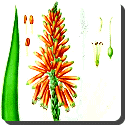 Aloe — Aloe is a genus containing about four hundred species of flowering succulent plants.
Aloe — Aloe is a genus containing about four hundred species of flowering succulent plants.
The genus is native to Africa and is common in South Africa’s Cape Province and the mountains of tropical Africa, and neighbouring areas such as Madagascar, the Arabian peninsula and the islands off Africa.
The APG II system (2003) placed the genus in the family Asphodelaceae. In the past it has also been assigned to families Aloaceae and Liliaceae. Members of the closely allied genera Gasteria, Haworthia and Kniphofia which have a similar mode of growth, are also popularly known as aloes. Note that the plant sometimes called “American aloe” (Agave americana), belongs to Agavaceae, a different family.
Most Aloes have a rosette of large, thick, fleshy leaves. The leaves are often lance-shaped with a sharp apex and a spiny margin. Aloe flowers are tubular, frequently yellow, orange or red and are borne on densely clustered, simple or branched leafless stems.
Many species of Aloe are seemingly stemless, with the rosette growing directly at ground level; other varieties may have a branched or un-branched stem from which the fleshy leaves spring. They vary in colour from grey to bright green and are sometimes striped or mottled.
Aloe species are frequently cultivated as ornamental plants both in gardens and in pots. Many Aloe species are highly decorative and are valued by collectors of succulents. It is claimed to have some medicinal effects which have been supported by scientific and medical research.
Since the era of Ancient Egypt, humans have been using aloe. Cleopatra was said to have used aloe as a beauty tool. The Egyptians discovered the healing powers of aloe. They used it as one of the ingredients of embalming fluid. In the 10th Century, the Europeans were introduced, where it became an important ingredient in many herbal medicines. By the 16th Century, aloe arrived in the West Indies, where still today it is grown and harvested.
Aloes are the expressed juice of the plant’s leaves. They are the solid residue remaining after evaporation of the drained liquid from transversely cut leaves of various Aloe spp.(not to be confused with Aloe Vera, a mucilage of the plant). When the leaves are cut, the juice that flows out is collected and evaporated. After the juice has been removed, the leaves are sometimes boiled to yield an inferior kind of aloes.
 Kids Portal For Parents India Kids Network
Kids Portal For Parents India Kids Network






